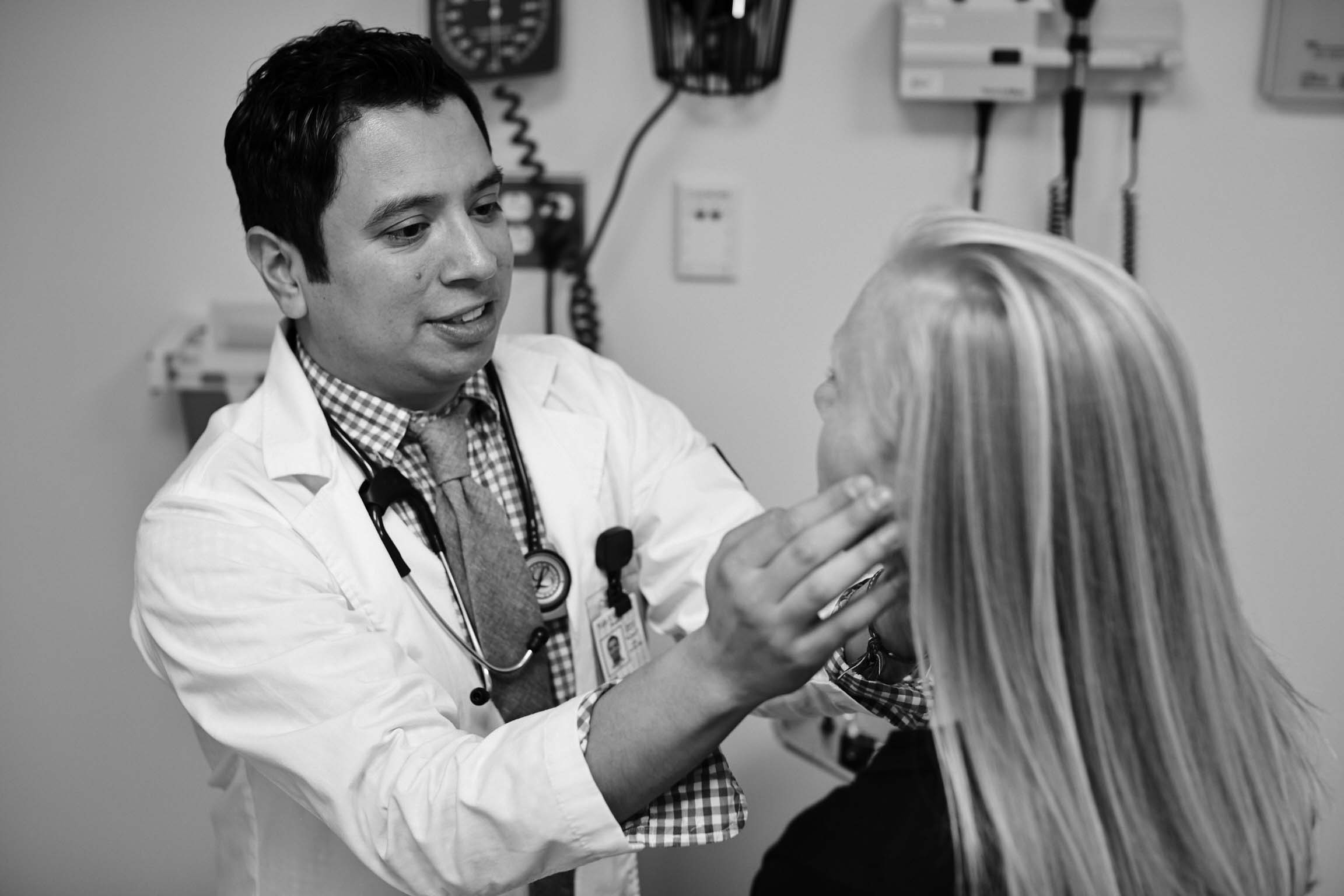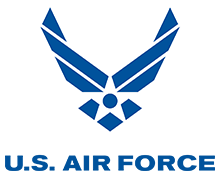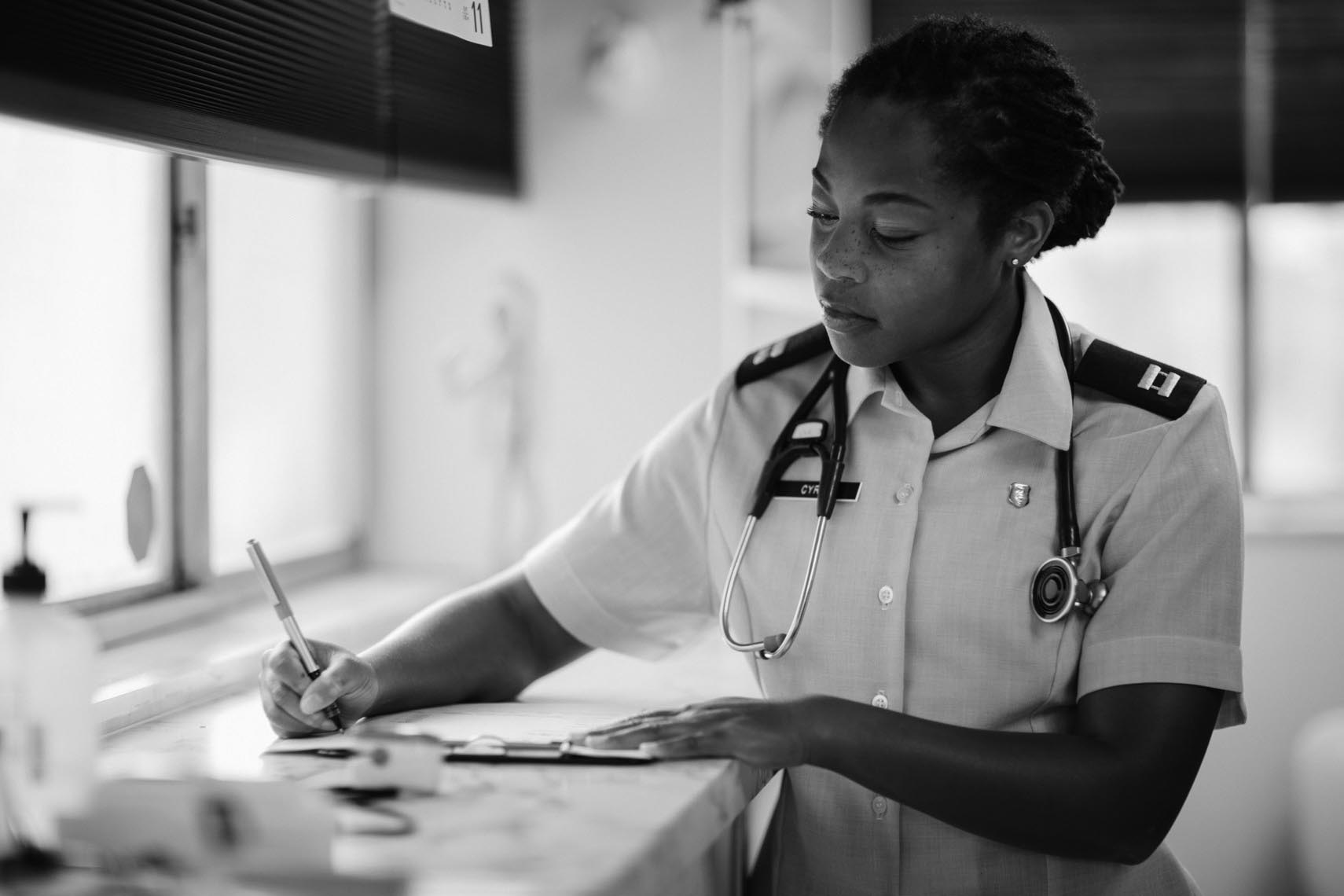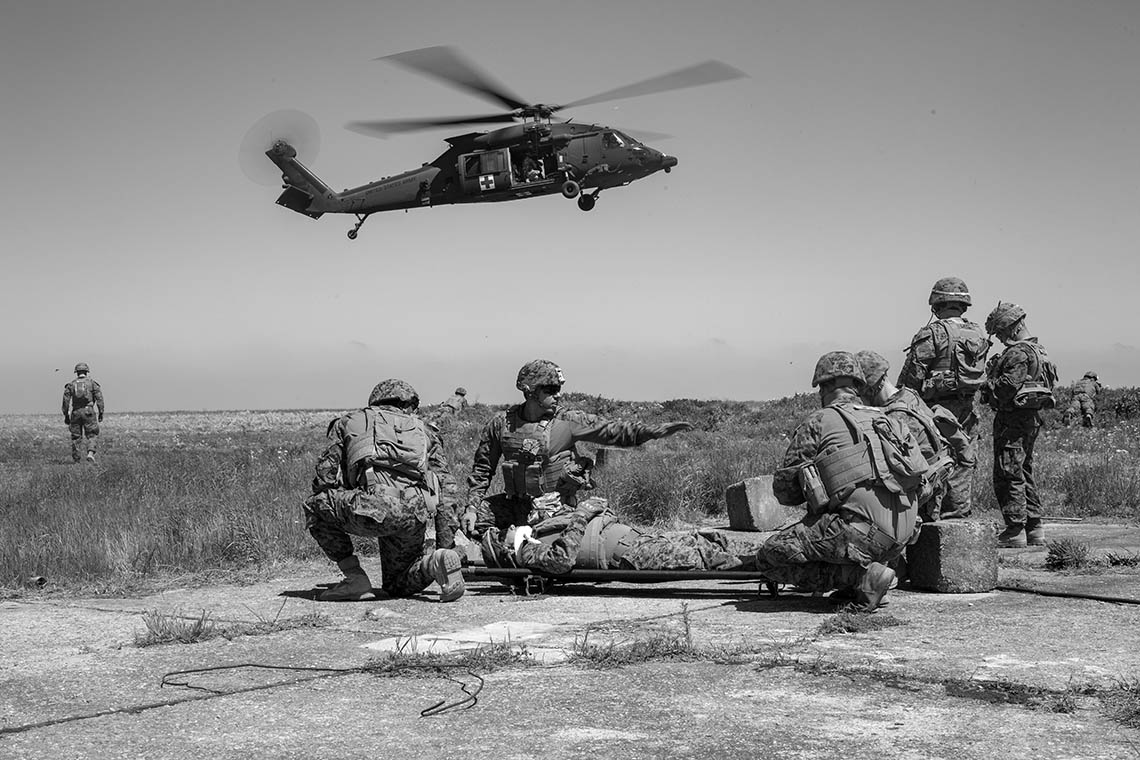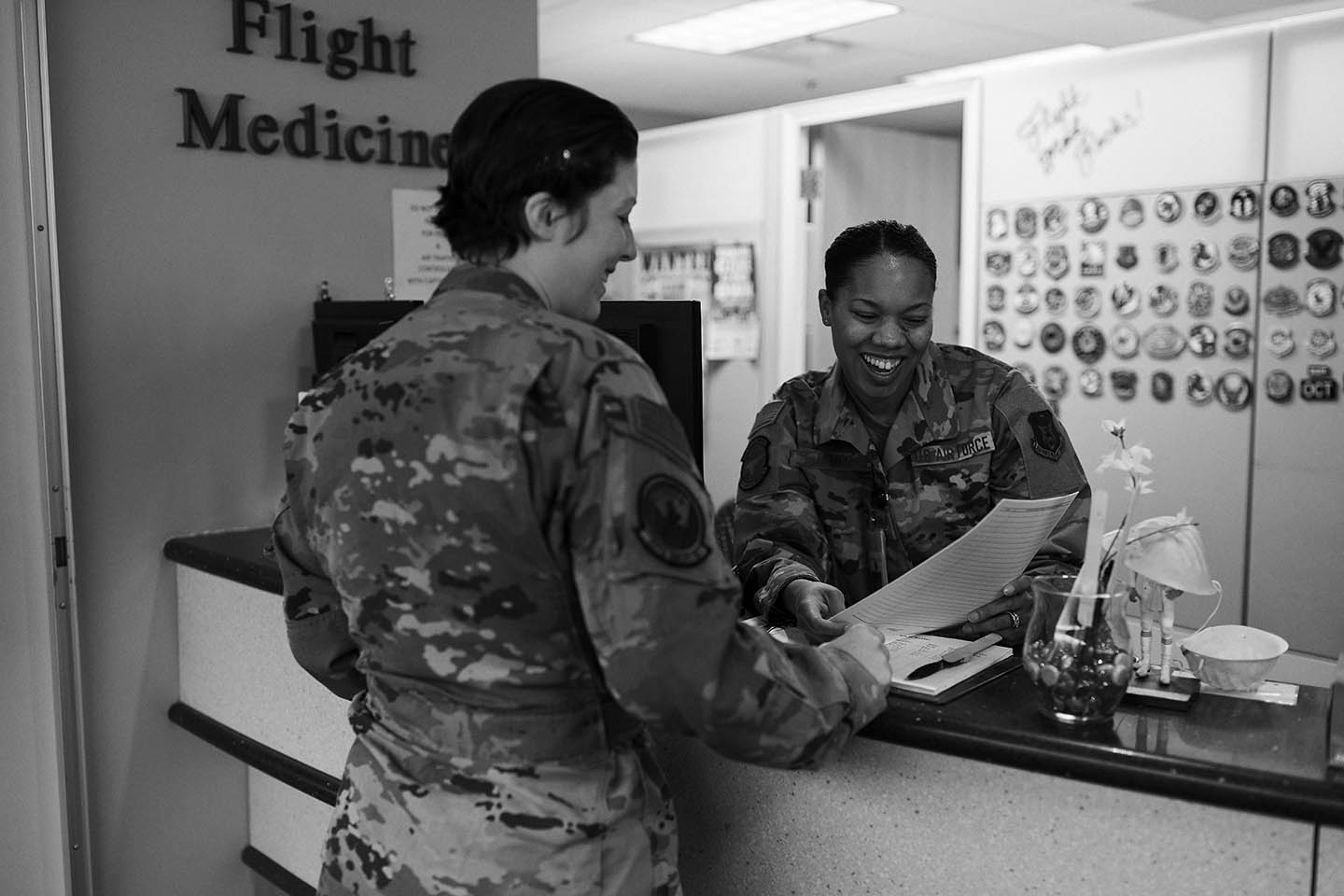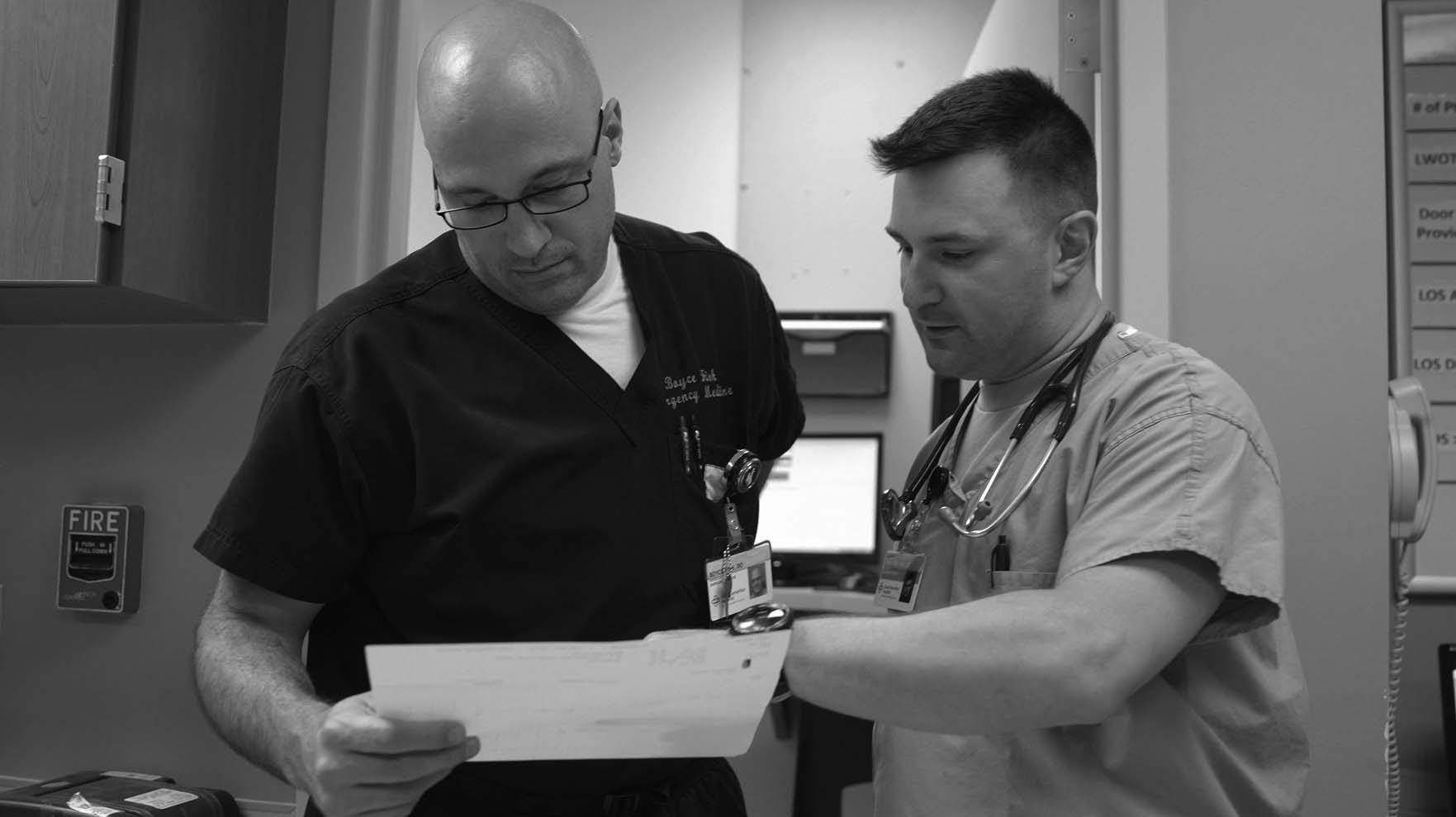- FAQs
- |
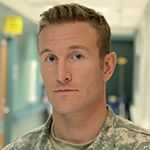
Hunter Winegarner, M.D.
Special Forces Battalion Surgeon
- Service Branch: Army
- Location: Fort Carson
- Specialty: Family Medicine
Army Captain Hunter Winegarner, M.D., is a Special Forces battalion surgeon at Fort Carson, Colo. He provides patient care to the Army’s most elite soldiers and is responsible for training medics who work in the field. In addition, he receives specialized training as a flight surgeon and a dive medical officer. Growing up in Alaska, Hunter developed a passion for ice hockey, and now coaches his son’s team.
”One of the best things about military medicine is that you can make your career be what you want it to be.“
Army Captain Hunter Winegarner, M.D., is a Special Forces battalion surgeon at Fort Carson, Colo. He provides patient care to the Army’s most elite soldiers and is responsible for training medics who work in the field. In addition, he receives specialized training as a flight surgeon and a dive medical officer. Growing up in Alaska, Hunter developed a passion for ice hockey, and now coaches his son’s team.
”One of the best things about military medicine is that you can make your career be what you want it to be.“
06:00 AM
"Today I'm jumping out of a helicopter as part of a training exercise for my unit. It's first thing in the morning, and I'm at the 'final manifest' waiting for my name to be called. We'll also get instructions on what to do once we get to the drop zone."
"Today I'm jumping out of a helicopter as part of a training exercise for my unit. It's first thing in the morning, and I'm at the 'final manifest' waiting for my name to be called. We'll also get instructions on what to do once we get to the drop zone."
06:32AM
"It's about a 30-minute drive out to the drop zone area on base. Drop zones generally have flat ground with limited obstacles. After getting off the bus, I line up with my group and wait for the parachutes to arrive."
"It's about a 30-minute drive out to the drop zone area on base. Drop zones generally have flat ground with limited obstacles. After getting off the bus, I line up with my group and wait for the parachutes to arrive."
07:00AM
Special Forces Operations Training: Helicopter Jump
As an Army Special Forces surgeon, Hunter is required to complete operations training. This morning, he jumps out of a helicopter to maintain his airborne status within his unit.
Special Forces Operations Training: Helicopter Jump
As an Army Special Forces surgeon, Hunter is required to complete operations training. This morning, he jumps out of a helicopter to maintain his airborne status within his unit.
WINEGARNER: My name is Hunter Winegarner. I'm a Captain in the Army, and I'm stationed with the 10th Special Forces Group here at Fort Carson, Colorado. I'm a doctor for our unit, and our unit is an airborne unit, which means we jump out of helicopters or airplanes on a pretty frequent basis. Myself and a lot of the guys that will be jumping today are cooks and medics and other MOSes that help the Green Berets get their job done.
This is me, in a parachute, ready to go.
Today we're going to jump out of Chinooks, which are CH-47s. They're the double-rotor, kind of funny-looking helicopters that kind of look like big school buses up there.
The helicopters will pick us up here and they'll bring us up to about 2,000 feet, and we'll fly at about 90 knots.
It's a static line jump, which means that we don't pull the rip cord - the rip cord's actually attached to the aircraft, and as we jump out it gets pulled. And then they give us the signal that we're one minute out, 30 seconds out, they tell us to stand by, and then somebody says "go." Before you know it you can see outside the door, and as soon as the arm goes up you just kind of charge off the back and get into position, chin to your chest, and then pretty hard shock as soon as the chute opens. Jumping out of a helicopter is probably the most extreme thing that we do, as far as adrenaline goes.
All right. So we just landed. Pretty sure my feet still work. Aah, gonna shake it out a little bit, put that off to the side. We've got our chest strap, leg lift, leg loops, throw all that stuff out. This is where I sit up straight and start putting stuff away. After the jump we need to go check in with the jump master at the chute turn-in, one, to let him know that I'm safe, I'm OK, and the other, to turn in my parachute, because I don't want to be walking around with this thing the rest of the day. And then we're free to go.
07:03AM
"Here's all my gear, ready to go. I have my 'chute, a helmet, my reserve 'chute, and the bag to pack our parachute in after we land. I also brought a backpack full of warm clothes and snacks because sometimes we can be out here for hours."
"Here's all my gear, ready to go. I have my 'chute, a helmet, my reserve 'chute, and the bag to pack our parachute in after we land. I also brought a backpack full of warm clothes and snacks because sometimes we can be out here for hours."
07:43AM
"Jumpmasters are identified by these red name bands. We have a jumpmaster for every group of soldiers that exits the aircraft, and we also have some non-flight jumpmasters on the ground who inspect our equipment. They are responsible for coordinating the jump and ensuring everyone's safety. Jumpmasters receive special training, and that's actually a school my unit wants me to go to."
"Jumpmasters are identified by these red name bands. We have a jumpmaster for every group of soldiers that exits the aircraft, and we also have some non-flight jumpmasters on the ground who inspect our equipment. They are responsible for coordinating the jump and ensuring everyone's safety. Jumpmasters receive special training, and that's actually a school my unit wants me to go to."
09:50AM
Figure 8 Parachute Fold
Hunter demonstrates the figure-eight technique he learned to fold his parachute so that it fits neatly into the bag.
Figure 8 Parachute Fold
Hunter demonstrates the figure-eight technique he learned to fold his parachute so that it fits neatly into the bag.
WINEGARNER: Start going like this.
0:06: Figure-eight wrap.
0:17: Like that.
0:27: Uh, you're kind of all bundled up here.
0:35: Trying to get a little -- a little bit of grass in there, but try and minimize that.
10:01AM
"Usually there's a medical vehicle waiting in the drop zone in case anyone gets injured and needs a medevac. I'm not personally in charge of today's medical plan, but that's not to say I wouldn't help someone next to me who was hurt."
"Usually there's a medical vehicle waiting in the drop zone in case anyone gets injured and needs a medevac. I'm not personally in charge of today's medical plan, but that's not to say I wouldn't help someone next to me who was hurt."
10:32AM
"Here's where I check in with my jumpmaster to turn in my parachute. Now it's time to head over to the clinic to see some patients."
"Here's where I check in with my jumpmaster to turn in my parachute. Now it's time to head over to the clinic to see some patients."
11:00AM
Special Forces Clinic Tour
Hunter gives a tour of the 10th Group Special Forces clinic, which has adopted the Soldier Centered Medical Home model where soldiers receive one-stop medical care.
Special Forces Clinic Tour
Hunter gives a tour of the 10th Group Special Forces clinic, which has adopted the Soldier Centered Medical Home model where soldiers receive one-stop medical care.
WINEGARNER: So here we are. We're at the 10th Group Special Forces Clinic that we share with Robinson Clinic. This is where we see all our patients every day. And this is also where patients would come if they were injured on the jump for Airborne Jumps.
We've actually just recently gone to what's called the Soldier Center Medical Home Model. And so basically the Soldier Center Medical Home is a place where a soldier can come and get all the things that they need in one stop. This hallway is mostly all exam rooms; they're multipurpose exam rooms. We have these treatment rooms; it's pretty nice to have something like this here in our clinic because we can take care of some of the sicker patients without having to send them up to the ER. We have our physical therapy room, and this is where we do a lot of our musculoskeletal physical therapy rehab. At the end of this hallway we would run into our pharmacy and our lab, and that's where patients can go and get their meds after they see us, and they can go and get blood drawn or do urine studies, those kind of things. So it's a one-stop-shop for them, so to speak.
Working here in this clinic is great, because, you know, we're a pretty small little family; this is a one place where all our patients can come and just get everything that they need, and we're here basically every single day, from morning till evening, unless we're out in the field doing something with the guys. And so our guys know that they can come here and find this if they need something from us.
11:14AM
"This is our collection of vaccines that we keep on hand here in our clinic. Our Special Forces guys are always going in and out of different countries, so we have a pretty long list of vaccines they're required to take."
"This is our collection of vaccines that we keep on hand here in our clinic. Our Special Forces guys are always going in and out of different countries, so we have a pretty long list of vaccines they're required to take."
11:30AM
Musculoskeletal Exam
A typical day for Hunter is spent in the clinic providing routine patient care for the Army's most elite soldiers. Many of his patients are in top physical condition, but often suffer from musculoskeletal injuries received during training exercises.
Musculoskeletal Exam
A typical day for Hunter is spent in the clinic providing routine patient care for the Army's most elite soldiers. Many of his patients are in top physical condition, but often suffer from musculoskeletal injuries received during training exercises.
WINEGARNER: Hey, it's me, Dr. Winegarner.
MALE: Hello, sir.
WINEGARNER: How's it going, man?
MALE: Good.
WINEGARNER: What brings you in today?
MALE: Uh, back's been hurting me for a while now. I've been doing a lot of PT, a lot of weight lifting, and I'm getting pretty, pretty sore in my lower back. It's starting to shoot down my leg.
WINEGARNER: Is that new or has that been going on for a while?
MALE: Off and on for probably about a year.
WINEGARNER: Most of our Green Berets are in top physical condition. They're much more physically fit than your average soldier, just because of the physical requirements of their training. That's a standard that they're held to.
Really what we're worried about is any type of nerve problems, so if our guys have just jumped out of an airplane and all of a sudden have back pain, they can sometimes cause some bulging in one of their desks in between the vertebrae, and that can press on a nerve and cause some pain in some of the radicular symptoms that he's kind of describing, with pain shooting down his left leg. What I'll do with these guys is I'll make sure that on their way out they'll go and check in with our physical therapist that's here in the building and get on the schedule with them, and that allows for some good continuity of care. We have some systems in place to inform our command, the commanders of the soldiers, as to what limitations they might have, medically speaking. So that's a big part of being a military doctor, is just keeping in mind that our soldiers are very active, and what kind of -- we have to always think of what kind of limitations they might have as far as their job is concerned.
From here, we'll walk down the hall to our physical therapist and go get him on the schedule for some back rehab.
12:47PM
SAM Splint Demonstration
Hunter explains a multi-use medical tool that can be used by soldiers when they're out in the field.
SAM Splint Demonstration
Hunter explains a multi-use medical tool that can be used by soldiers when they're out in the field.
WINEGARNER: If I'm going climbing or going hiking or doing any type of outdoor activity, and I've got enough room in my backpack, the SAM splint is pretty much the most useful tool to bring with you. This one thing, it looks like a piece of foam, but it's got some aluminum in it, and it's very malleable. And so you can take this, and if somebody has a really bad fall and you're worried about a C-spine injury, you can create a C-collar with it, and basically there's different techniques for creating C-collars where you can really immobilize the neck. And just by putting a couple kinks in the SAM splint, you can get some good immobilization of the neck. Same thing for splinting a broken arm or a broken leg: you can just take this, shape it, you know, size it to where you want it to go, and then if you just put a couple little kinks in it, this then becomes a nearly rigid splint that you can duct-tape to somebody's arm, or just use an extra shirt or an extra layer that you have and tie it on there or anything you got, and that'll at least provide some pain relief while you're evacuating somebody.
01:10PM
Benefits For Army Doctors
Hunter explains the many benefits that help support his family and his career.
Benefits For Army Doctors
Hunter explains the many benefits that help support his family and his career.
WINEGARNER: You know, there's so many benefits, it's hard to even count, but really, the things that drew me into being an Army doctor was, first and foremost, they paid for school, which is awesome. I also was at the military's med school, which was great because I got married while I was there, and so not only did I have health coverage through the military for myself but my wife also received healthcare and all the perks of being active-duty military then. And then during residency, we got all the same perks. So we were commissioned as captains in residency, and we were paid as active-duty captains in the military, which is much higher pay rate than a civilian in a similar job would be paid.
I like pretty much everything about my job, really. I like the flexibility that I'm allowed to have, I like the way we run our clinic. There's a lot of autonomy in our job, and we have multiple hats that we wear, and so we'll be here in clinic and we'll wear our doctor hats and we'll do regular doctor things where we see patients and do regular doctor-type stuff. And then we'll also go over to our battalion, where we're also a member of the staff for our battalions. The role there is we advise our commander for medical issues that might come up for missions or training, that kind of thing. If you want to have that kind of -- chaotic at times, but also very fun lifestyle where you get to go and jump out airplanes or, you know, go learn how to be a combat diver, and take care of that kind of soldier, then yeah, it's a pretty good job, so.
02:12PM
"These are simulation IEDs [improvised explosive device] we use to make the training atmosphere more realistic. You want your trainings to be as lifelike as possible so that the medics learn how to remain calm in a stressful situation. I think adding an element of stress leaves a lasting impression and helps them retain more information."
"These are simulation IEDs [improvised explosive device] we use to make the training atmosphere more realistic. You want your trainings to be as lifelike as possible so that the medics learn how to remain calm in a stressful situation. I think adding an element of stress leaves a lasting impression and helps them retain more information."
01:55PM
"Just arrived at the Medical Simulation Training Center (MSTC) to lead a training exercise for one of my medics. This area is designed to mirror various scenarios you might come across in a field trauma environment, and we use simulated mannequins to practice our medical skills."
"Just arrived at the Medical Simulation Training Center (MSTC) to lead a training exercise for one of my medics. This area is designed to mirror various scenarios you might come across in a field trauma environment, and we use simulated mannequins to practice our medical skills."
02:00PM
Medical Simulation Training Center Exercise
Special operations physicians are responsible for training the medics who practice medicine in the field during deployments. This afternoon, Hunter oversees a medic who is training a group of soldiers during a Tactical Combat Casualty Care (TC3) exercise at Fort Carson's Medical Simulation Training Center (MSTC). During the training, they use simulated mannequins to practice their medical skills.
Medical Simulation Training Center Exercise
Special operations physicians are responsible for training the medics who practice medicine in the field during deployments. This afternoon, Hunter oversees a medic who is training a group of soldiers during a Tactical Combat Casualty Care (TC3) exercise at Fort Carson's Medical Simulation Training Center (MSTC). During the training, they use simulated mannequins to practice their medical skills.
WINEGARNER: All right, guys, thanks for coming out this morning. So we're here today to do some good TC3 training. Nick, you're our medic today, and so you're going to be kind of taking point, and he's going to be the boss. I'm going to be in the background; I'll be helping direct what's going on.
All right, Nick, take it from here.
NICK: And you'll be point man on the patrol. You'll be on the right side of the wedge, along with you. When we take casualties, I'll assign roles when we get there.
WINEGARNER: All right, guys, you've got superior firepower.
NICK: Left side, move to the vehicle. Right side, move to us. Get on the front side of the vehicle.
MALE: Hey, we need a hand over here.
WINEGARNER: At this stage, which we would call care under fire, is managing massive hemorrhages.
NICK: You get the bleeding stopped?
MALE: Bleeding's stopped.
MALE 1: Bleeding's stopped.
WINEGARNER: So we're moving from...
NICK: You with me? OK.
WINEGARNER: What we would have considered care under fire out there, where all they really did was stop the bleeding and get him somewhere more secure, to what we would call tactical field care here. So this is where our medic's going to take charge; he's going to start addressing every problem that he can find. Nick, what's something that you might have to worry about on this guy with a chest wound, now you've occluded his chest wound?
NICK: Might have to needle d him.
WINEGARNER: OK.
NICK: We're going to check for bilateral rise. He was good; his respirations weren't too high either. [booming noise]
MALE: We gotta get going.
WINEGARNER: All right, guys, it's not safe anymore. Let's get going. [sounds of gunfire] Move out, move out. So this is simulating — we would, you know, probably have to move him to somewhere safe for a helicopter to land, and then from here we're going to take the patient to a higher level of care. You know, now we're more in a field-hospital setting.
02:10PM
"The folks at the Medical Simulation Training Center use this device to control the rescue mannequins during the training exercise. They can move the limbs, simulate arterial bleeding and add sound effects, such as breathing. It's pretty neat."
"The folks at the Medical Simulation Training Center use this device to control the rescue mannequins during the training exercise. They can move the limbs, simulate arterial bleeding and add sound effects, such as breathing. It's pretty neat."
02:37PM
"Nick and the medics diagnosed the trauma SIM patient with a bilateral pneumothorax, so they tried a needle decompression to alleviate the pressure. This is a common field intervention, and the patient usually responds pretty quickly."
"Nick and the medics diagnosed the trauma SIM patient with a bilateral pneumothorax, so they tried a needle decompression to alleviate the pressure. This is a common field intervention, and the patient usually responds pretty quickly."
02:55PM
"This is inside the Medical Simulation Training Center, which is set up to mimic a field hospital. We can create a more intense environment in here by turning down the lights, adding strobes and piping in combat-type sounds and music."
"This is inside the Medical Simulation Training Center, which is set up to mimic a field hospital. We can create a more intense environment in here by turning down the lights, adding strobes and piping in combat-type sounds and music."
03:00PM
Escharotomy Procedure Training
Hunter supervises his medic Nick as he performs an escharotomy on a simulation mannequin.
Escharotomy Procedure Training
Hunter supervises his medic Nick as he performs an escharotomy on a simulation mannequin.
WINEGARNER: At this point, this patient is simulating the same patient that we brought — uh, that we collected and brought to the helicopter. Now he's in a higher level of care. He should have most of the same injuries that he had before; they're going to find some more injuries.
For some of these guys, it's going to be the first time they see anything like this, because they're not medical guys at all. So the medic and I will be kind of geeking out on medicine and stuff, and we'll be trying to teach some of these non-medicine folks a little bit of what we're doing.
MALE: We need an escharotomy here. His compliance isn't good, and he's not moving a lot of air right now.
WINEGARNER: OK.
MALE: Because he feels really tense in his chest
WINEGARNER: So explain to me how you're going to do that.
MALE: Gonna clean the area with betadine, and then we're going to go with either a scalpel and cut anterior axillary line from just below the clavicle all the way down to the costal margins —
WINEGARNER: OK.
MALE: And see if that affects — do that bilaterally.
WINEGARNER: OK.
MALE: And if his breathing gets better, we're going to...
WINEGARNER: You probably want to cross here too.
MALE: Roll with that, but we might have to go one across the diaphragm.
WINEGARNER: OK.
MALE: We're going to go until we see the subcutaneous fat, and the skin is going to separate due to the pressure.
WINEGARNER: One thing I've had to learn as a doc in a leadership role is that it's not my training — it, I'm leading the training and these guys are the ones who are reaping all the benefits.
With you guys not being medical people, this was a whole — this was a high level of medical s— medical things going on, OK? So we were trying to walk through it with you; mainly we wanted you guys to just be exposed to it, and, you know, in the future, worst-case scenario, who knows, you might find yourself having to help out in this kind of setting. So at least now you've been through it once. I know this was a first for a lot of you guys, so thanks a lot for coming out, and Nick, I know you definitely got a lot out of this, so good job. Good work. Proud of you guys.
M: For sure? Thanks, sir.
03:01PM
"The M.A.R.C.H. algorithm is a good way to remember every problem that needs to be addressed when encountering a trauma patient. We check for massive hemorrhage, alertness and airways, respiration, circulation and hypothermia."
"The M.A.R.C.H. algorithm is a good way to remember every problem that needs to be addressed when encountering a trauma patient. We check for massive hemorrhage, alertness and airways, respiration, circulation and hypothermia."
03:22PM
For the escharotomy training, the MSTC guide placed a piece of skin over the mannequin and used a blowtorch to create the burn appearance. Underneath that was a thin piece of foam and Saran wrap with some simulated blood, and underneath that was a yoga mat, which was supposed to be more deeper muscle tissue. This helped to simulate the various layers of tissue you'd encounter as you cut through the skin and the fascia.
For the escharotomy training, the MSTC guide placed a piece of skin over the mannequin and used a blowtorch to create the burn appearance. Underneath that was a thin piece of foam and Saran wrap with some simulated blood, and underneath that was a yoga mat, which was supposed to be more deeper muscle tissue. This helped to simulate the various layers of tissue you'd encounter as you cut through the skin and the fascia.
03:35PM
Common Combat Injuries
Hunter explains common injuries received during conflict and why it's important that all soldiers learn basic medical skills.
Common Combat Injuries
Hunter explains common injuries received during conflict and why it's important that all soldiers learn basic medical skills.
WINEGARNER: The common wounds that we really want to train hard are the ones that are — that we've identified as being causes of death that are preventable. So there's been some landmark studies out of Iraq and Afghanistan that have looked at what people die of on the battlefield, and the big things that we've identified that guys can basically intervene on and make a difference on are the massive hemorrhage, and so putting tourniquets on and stopping the bleeding as fast as we can is the biggest thing. And then we've also developed even more to get at more of the junctional wounds, which would be kind of up here in the armpits or down here in the groin area. Those parts of the body are really hard to put a tourniquet on, and you can't necessarily stop the bleeding with that, but we’ve developed special gauzes and even some clamps that we can use in the field to stop those bleeding sites. And so, so massive hemorrhage is always something that we're always going to train when we do this TC3 training. And then the pneumothorax, which we also simulated outside, that's another thing that's been identified as potential intervention that guys can do in the field and will save a life, because with penetrating or blunt-chest trauma, there can be basically a ruptured lung and then air leaking into the chest that collapses the lung, and then can even compress on the heart and cause circulation problems. And so just by simply putting a needle in and decompressing that, we can release the tension that's inside the chest and get the blood pumping again.
03:47PM
Trauma Simulation Mannequin Demo
Military medics train with advanced trauma mannequins designed to simulate common field injuries. Hunter demonstrates how they can be used during training exercises.
Trauma Simulation Mannequin Demo
Military medics train with advanced trauma mannequins designed to simulate common field injuries. Hunter demonstrates how they can be used during training exercises.
WINEGARNER: These are very advanced SIM, SIM men. These ones in here are fully electronic. We have the ability to hook them up to monitors, and they'll give real live feedback as far as pulses go. They'll breathe, you'll see the rise and fall of the chest; if you were to listen to them you could hear the heart rate, you could hear the lungs. At times during this scenario we can make them talk, we can make them blink, we can make them look around, we can do all kinds of things with these guys. Being able to set them up for IV or IO access, doing these escharotomies, these are all things that we're able to do, so. In this day and age we try and make it as realistic as possible, and these SIM men, they're very expensive, but they do a very good job of doing that.
So yeah, there's — there — simulation tools that we have come a long way over the last decade, so that's really nice.
04:17PM
High Angle Ropes Rescue Training
Hunter trains soldiers on how to perform a high-angle rope rescue. It's not a clinical medicine skill, but it's an operational skill that Hunter teaches his medics if they need to move a patient up difficult terrain.
High Angle Ropes Rescue Training
Hunter trains soldiers on how to perform a high-angle rope rescue. It's not a clinical medicine skill, but it's an operational skill that Hunter teaches his medics if they need to move a patient up difficult terrain.
WINEGARNER: So thanks for coming out. We're going to do a little bit more advanced rescue training today, so this is something that you might need to use in the field if you're ever moving a patient over long distances or over difficult terrain. What this is called, it is called a three to one pulley system, to help you get a mechanical advantage to move somebody heavy, like our patient here today, up over difficult terrain.
Bit of a hike.
So we're going to run our anchor all the way around this, and then we're going to — it'll be in a straight line all the way down to our patient, so this is like the perfect spot, OK?
MALE: Pull. Pull. Pull. Pull.
WINEGARNER: So Roger, you safe there?
ROGER: Yeah.
WINEGARNER: You can probably unstrap. You guys want to come over here and see what — see what I'm seeing?
I was a little surprised we were having to work as hard as we were to get both Roger and the patient up, so we gotta make sure that the rope goes through the pulley, right? It's the first time, it's no big deal. You've never done anything like this, so next time you won't do that, right?
MALE 1: No, sir.
WINEGARNER: Good job, guys. That's your intro to high-angle rescue.
04:33PM
"Here is the pulley and ropes we use to make the three-to-one pulley system, which helps give us a mechanical advantage to move somebody heavy up over difficult terrain. The pulleys themselves are actually what's called a Prusik Minding Pulley."
"Here is the pulley and ropes we use to make the three-to-one pulley system, which helps give us a mechanical advantage to move somebody heavy up over difficult terrain. The pulleys themselves are actually what's called a Prusik Minding Pulley."
05:39PM
"This is my hockey jersey from when I was in med school at USUHS [Uniformed Services University of the Health Sciences]. We were called the Fightin' Docs. I made some really good friends on the team who I still keep in touch with today."
"This is my hockey jersey from when I was in med school at USUHS [Uniformed Services University of the Health Sciences]. We were called the Fightin' Docs. I made some really good friends on the team who I still keep in touch with today."
06:11AM
"Last weekend, we bought Cormac a new pair of hockey skates. He says they make him go super fast."
"Last weekend, we bought Cormac a new pair of hockey skates. He says they make him go super fast."
06:27PM
"This is my wife Morgan and my two-year-old daughter Reese. This is Reese's first time on skates, and that's right around the age we started Cormac."
"This is my wife Morgan and my two-year-old daughter Reese. This is Reese's first time on skates, and that's right around the age we started Cormac."
06:41PM
"I put these gloves down on the rink so that Cormac can learn how to make turns on his skates while keeping the puck in control with his stick."
"I put these gloves down on the rink so that Cormac can learn how to make turns on his skates while keeping the puck in control with his stick."
06:55PM
"Cormac and I made a snowman out of ice shavings. I've been playing hockey all my life, so it's really important to me to be out here on the rink and spend this kind of time with my family."
"Cormac and I made a snowman out of ice shavings. I've been playing hockey all my life, so it's really important to me to be out here on the rink and spend this kind of time with my family."
07:00PM
Ice Hockey With Family And Friends
When Hunter is off-duty, spending time with his family is top priority. Tonight after work, Hunter and his family head to the local ice rink to meet with friends and skate with members of his son's ice hockey team.
Ice Hockey With Family And Friends
When Hunter is off-duty, spending time with his family is top priority. Tonight after work, Hunter and his family head to the local ice rink to meet with friends and skate with members of his son's ice hockey team.
WINEGARNER: So we're getting on home, and spending time with the family at five o'clock or so every day is enough time before my kids go to bed — they usually go and do something fun. A couple times a week we'll go and do some ice hockey with my son.
CORMAC: Daddy's home! Yay!
WINEGARNER: Hey, buddy.
CORMAC: Hi!
WINEGARNER: How's it going? You guys ready for hockey tonight?
REESE: Yeah!
WINEGARNER: Yeah?
MORGAN: Are you ready?
WINEGARNER: Yeah? Cormac, can you help me with any of these? I need some help, big guy.
REESE: I'll drive.
MORGAN: Reese wants to drive. (laughter)
WINEGARNER: We started Cormac out when he was — how old were you when you first started skating?
CORMAC: Two.
WINEGARNER: Two. I think we got him on his first set of skates pretty quickly after he learned how to walk, but now how old are you?
CORMAC: Four.
WINEGARNER: He's four, and that's kind of when kids can start skating with a group and doing actual hockey stuff.
Good. Coming around. All the way around. And when you get it, take a shot. Oh my goodness, you shot all the way down the ice! Holy cow!
I guess I started skating when I was five, and growing up in Alaska it was kind of the thing to do. And I've continued to play, even as a doctor. Some of the guys that came out today are guys that I've met with my unit that also play hockey, and it continues to be a big part of my life and something that's really important to me. It's a misconception if people think that being an Army doctor is going to be too busy to have a life outside of work. As this guy can attest, there's times where it's busy and there's times where it's hard to make it happen, but for the most part it's part of the lifestyle of being an Army doctor that you get time with your family.
5 PHYSICIANS. 24 HOURS.

